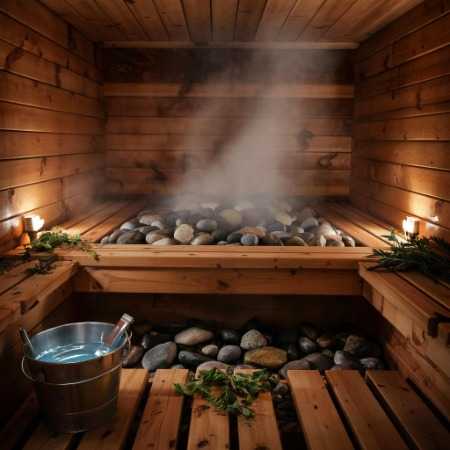Insulating the steam room is a critical stage in sauna construction and renovation, affecting heating efficiency, comfort, and structural durability. The steam room operates under high temperature and humidity, requiring heat retention and minimal heat loss. Proper insulation reduces fuel consumption, speeds up heating, and creates an optimal microclimate for steaming.
Incorrect insulation leads to wall cooling, condensation, dampness, wood rot, and mold growth. Heat escapes through uninsulated surfaces, lowering energy efficiency and increasing operating costs.
This article thoroughly explores all aspects of steam room insulation: materials, technologies, installation features, and common mistakes to avoid. This ensures a comfortable, economical sauna that lasts for years.
Microclimate Features of the Steam Room and Their Impact on Insulation Material Choice
The steam room experiences elevated temperatures (often 90–110 °C) and high humidity (up to 80–100%). Such extremes impose specific requirements on insulation materials. The material must withstand temperature fluctuations, resist moisture absorption, emit no toxic substances when heated, and have adequate vapor permeability.
Low vapor permeability causes moisture buildup inside structures, leading to wood rot and mold. Excessive vapor permeability without vapor barriers results in heat loss and reduced insulation efficiency.
Thus, insulation must balance thermal resistance and vapor permeability. Hot steam condenses on cold surfaces, so insulation and vapor barriers must be properly combined.
Types of Insulation for Steam Rooms: Overview and Comparative Analysis
Various materials are used for steam room insulation, each with pros and cons. Common types include mineral wool, basalt wool, polystyrene foam (EPS), extruded polystyrene foam (XPS), polyurethane foam (PUR), and natural insulators like flax fiber, jute, sawdust.
Mineral and basalt wool have good heat resistance and vapor permeability, are fire-resistant and moisture-stable if protected. They require quality vapor barriers and moisture protection.
Polystyrene foams have low vapor permeability, high strength, and moisture resistance but may emit harmful substances when heated. Use cautiously with vapor barriers.
Polyurethane foam offers excellent insulation and adhesion but needs professional installation.
Natural insulators are eco-friendly and breathable but less durable and require maintenance.
See the comparison table above for key properties.
Insulation Technologies and Layering Schemes in the Steam Room
Insulating a steam room is a layered process where each layer serves a function. Proper sequence and quality are critical to retain heat and prevent moisture issues.
The first layer is the load-bearing wall (timber or logs). Next is the insulation layer installed between battens or framing. Above insulation is vapor barrier protecting insulation and wood from steam and condensation.
The interior finish (wood paneling) is vapor-permeable and moisture-resistant. A ventilation gap between insulation and finish prevents moisture accumulation.
Sometimes external waterproofing is applied, especially on walls exposed to outside.
Features of Insulating the Ceiling and Floor in the Steam Room
Ceiling and floor require special attention as they are major heat loss points. Ceiling insulation uses similar materials as walls with strict vapor barrier installation since hot steam rises and condenses on cold surfaces.
Floors often have wooden decking over insulation and waterproofing layers. Insulation must be moisture-resistant and stable under heat and moisture. XPS or PUR are common choices for floor insulation.
Good drainage and ventilation under the floor prevent water stagnation and dampness, protecting insulation and wood.
Common Mistakes in Steam Room Insulation and How to Avoid Them
A common mistake is incorrect material choice ignoring vapor permeability and heat resistance. Using low vapor permeability insulation without vapor barriers traps moisture and damages structure.
Another error is poor installation: no ventilation gap, loose insulation, damaged vapor barrier cause condensation and reduce insulation efficiency.
Incorrect insulation thickness reduces effectiveness. Too thin fails to retain heat; too thick may cause overheating and deformation.
Consider usage frequency: infrequent use requires more intensive insulation for faster heating and longer heat retention.
Ventilation in the Steam Room and Its Role in Insulation System
Ventilation is essential for removing excess moisture, preventing mold and rot, and distributing heat evenly.
Steam rooms need supply and exhaust ventilation with adjustable dampers. Ventilation should avoid drafts that reduce comfort and increase heat loss.
Integrating ventilation with insulation requires careful design to maintain vapor barriers and avoid excessive insulation cooling.
Ecological and Sanitary Aspects of Steam Room Insulation
Insulation must be safe for health, emitting no toxic substances when heated or exposed to steam.
Natural insulators like flax and jute are eco-friendly but require antiseptic and fire retardant treatment.
Synthetic materials must have fire safety certificates and sanitary approvals. Avoid cheap insulators emitting formaldehyde or other harmful chemicals.
Modern Innovations in Steam Room Insulation
Modern tech enables combined insulation systems with advanced materials. Aerogels are ultra-light, highly efficient insulators usable in thin layers.
Vacuum insulation panels provide minimal heat loss at low thickness.
Vapor barrier membranes with adjustable permeability adapt to conditions automatically.
Such innovations allow more energy-efficient and durable saunas.
Final Recommendations for Steam Room Insulation
Steam room insulation must be comprehensive, considering microclimate, materials, and construction. Choose insulation with proper thermal and vapor permeability properties.
Install vapor barriers correctly and ensure ventilation gaps. Pay special attention to ceiling and floor insulation as major heat loss areas.
Avoid common mistakes: wrong materials, poor installation, lack of ventilation. Use modern materials and technologies for durability and comfort.
Comparative Table of Steam Room Insulation Technologies
| Insulation Technology | Advantages | Disadvantages | Recommended Thickness (mm) | Application Areas |
|---|---|---|---|---|
| Mineral Wool + Vapor Barrier | High vapor permeability, fire resistance | Needs moisture protection | 100–150 | Walls, ceiling |
| Polystyrene + Vapor Barrier | High moisture resistance, strength | Low vapor permeability, flammable | 50–100 | Floors, exterior walls |
| Polyurethane Spray Foam | Excellent insulation, airtightness | High cost, professional installation needed | 50–80 | Walls, ceiling |
| Natural Insulators | Eco-friendly, vapor permeable | Low durability, maintenance required | 100–150 | Walls, ceiling |

